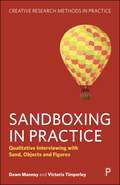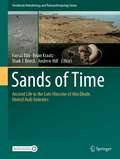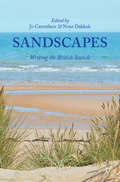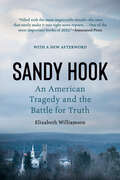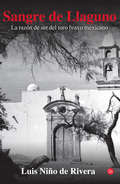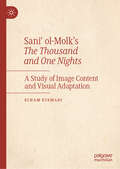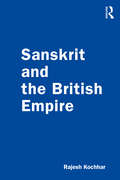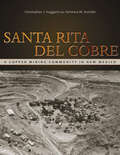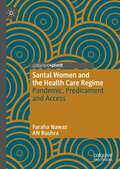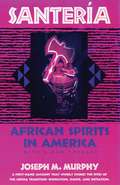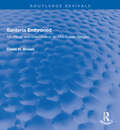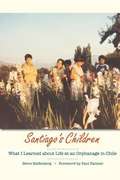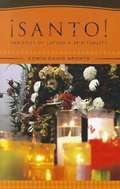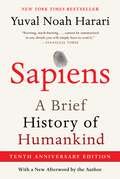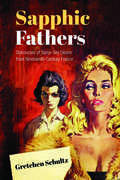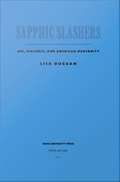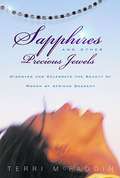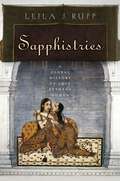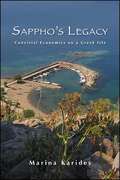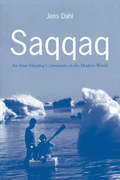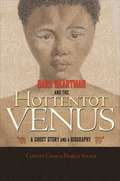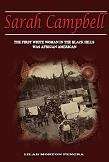- Table View
- List View
Sandboxing in Practice: Qualitative Interviewing with Sand, Objects, and Figures (Creative Research Methods in Practice)
by Dawn Mannay Victoria TimperleyThis is the essential guide to the innovative qualitative research technique of sandboxing. Originating from play therapy, sandboxing enables children, young people, and adults to create three-dimensional scenes using miniature figures and everyday objects in a sand-filled tray. Creating these sand scenes offers opportunities for individuals and groups to reflect on and represent memories, everyday experiences, and ideas about the future, which are then shared and discussed. Offering an invaluable resource for students, researchers, and practitioners, this comprehensive book: - introduces a creative and engaging approach to qualitative data generation; - features key international case studies, real-world examples, and thoughtful reflections on the method's strengths and limitations; - equips readers with the tools needed to effectively implement sandboxing in their research journey. By drawing on creativity, reflexivity, ethics and expertise this book unlocks sandboxing's potential to transform your research with an inventive and imaginative approach.
Sands of Time: Ancient Life in the Late Miocene of Abu Dhabi, United Arab Emirates (Vertebrate Paleobiology and Paleoanthropology)
by Andrew Hill Faysal Bibi Brian Kraatz Mark J. BeechThis monograph presents the results of over 10 years of paleontological and geological survey in the Baynunah Formation of the United Arab Emirates. Exposed widely in western Abu Dhabi Emirate, the Baynunah Formation and its fossils provide the only record of terrestrial environments and evolution in the Arabian Peninsula during the late Miocene epoch (12-5 Ma). This volume describes new fossils collected since 2002, presented systematically by taxon, and including mammals, reptiles, and invertebrates, as well as fossil trackways. The discoveries are framed within the results of new geological, geochemical, and geochrononological analyses, providing an updated and synthetic view of the age, environments, and biogeographic relationships of this important fossil assemblage.
Sandscapes: Writing the British Seaside
by Jo Carruthers Nour DakkakSandscapes: Writing the British Seaside reflects on the unique topography of sand, sandscapes, and the seaside in British culture and beyond. This book brings together creative and critical writings that explore the ways sand speaks to us of holidays and respite, but also of time and mortality, of plenitude and eternity. Drawing together writers from a range of backgrounds, the volume explores the environmental, social, personal, cultural, and political significance of sand and the seaside towns that have built up around it. The contributions take a variety of forms including fiction and nonfiction and cover topics ranging from sand dunes to sand mining, from seaside stories to shoreline architecture, from sand grains to global sand movements, from narratives of the setting up of bed and breakfasts to stories of seaside decline. Often a symbol of aridity, sand is revealed in this book to be an astonishingly fertile site for cultural meaning.
Sandy Hook: An American Tragedy and the Battle for Truth
by Elizabeth WilliamsonBased on hundreds of hours of research, interviews, and access to exclusive sources and materials, Sandy Hook is Elizabeth Williamson&’s landmark investigation of the aftermath of a school shooting, the work of Sandy Hook parents who fought to defend themselves, and the truth of their children&’s fate against the frenzied distortions of online deniers and conspiracy theorists. On December 14, 2012, a gunman killed twenty first-graders and six educators at Sandy Hook Elementary School in Newtown, Connecticut. Ten years later, Sandy Hook has become a foundational story of how false conspiracy narratives and malicious misinformation have gained traction in society. One of the nation&’s most devastating mass shootings, Sandy Hook was used to create destructive and painful myths. Driven by ideology or profit, or for no sound reason at all, some people insisted it never occurred, or was staged by the federal government as a pretext for seizing Americans&’ firearms. They tormented the victims&’ relatives online, accosted them on the street and at memorial events, accusing them of faking their loved ones&’ murders. Some family members have been stalked and forced into hiding. A gun was fired into the home of one parent. Present at the creation of this terrible crusade was Alex Jones&’s Infowars, a far-right outlet that aired noxious Sandy Hook theories to millions and raised money for the conspiracy theorists&’ quest to &“prove&” the shooting didn&’t happen. Enabled by Facebook, YouTube, and other social media companies&’ failure to curb harmful content, the conspiracists&’ questions grew into suspicion, suspicion grew into demands for more proof, and unanswered demands turned into rage. This pattern of denial and attack would come to characterize some Americans&’ response to almost every major event, from mass shootings to the coronavirus pandemic to the 2020 presidential election, in which President Trump&’s false claims of a rigged result prompted the January 6, 2021, assault on a bastion of democracy, the U.S. Capitol. The Sandy Hook families, led by the father of the youngest victim, refused to accept this. Sandy Hook is the story of their battle to preserve their loved ones&’ legacies even in the face of threats to their own lives. Through exhaustive reporting, narrative storytelling, and intimate portraits, Sandy Hook is the definitive book on one of the most shocking cultural ruptures of the internet era.
Sangre de Llaguno. La razón de ser del toro bravo mexicano
by Luis Niño de RiveraLa crónica imprescindible para todos aquellos que aman la Fiesta Brava en MéxicoEn esta nueva edición, corregida y aumentada, Luis Niño de la Rivera se basa en una extensa documentación para contar la historia de los hermanos Llaguno, quienes hace poco más de un siglo fundaron la ganadería emblemática de la fiesta brava en nuestro país.A partir de unas cuantas reses bravas traídas de España, los hermanos Llaguno se empeñaron en lograr en su crianza la bravura y el trapío necesarios para la buena lidia. Con ello lograron desarrollar el toro que ha sostenido la tauromaquia mexicana durante los últimos cien años. Varios de los más famosos toreros y ganaderos constataron los resultados logrados a partir de muchos años de empeño indomable, de intuición y trabajo, no exento de fallas y sinsabores pero siempre tenaz. Luis Niño de Rivera cuenta las andanzas, logros y tropiezos de Antonio y Julián Llaguno, los colores de sus épocas ylos minuciosos registros de crianza que les permitieron convertirse en éxitos ganaderos y personajes de leyenda.
Sani‘ ol-Molk’s The Thousand and One Nights: A Study of Image Content and Visual Adaptation
by Elham EtemadiThis book examines The Thousand and One Nights by Abol-Hassan Khan Sani‘ ol-Molk Ghaffari (1813/1814-1867), of the content of the illustrations of the main story, the story of Shahrzad and Shahrbaz, as well as a codicological study of the manuscript. It intends to explain how Sani‘ ol-Molk complicates the visual frame by adaptive strategies that build on the relationship between presented objects inside an illustration and the meanings that could be conventionally attributed to them from outside of the image. Examining the illustrations of the manuscript shows how Sani‘ ol-Molk’s visualization of the main story of The Thousand and One Nights adds to the narrative and adapts it to convey meaning(s) that transcend the story the illustrations refer to.
Sanrakshan Shastra (Karyapustika) class 9 - Maharashtra Board: संरक्षण शास्त्र (कार्यपुस्तिका) ९वीं कक्षा - महाराष्ट्र बोर्ड
by Maharashtra Rajya Pathyapustak Nirmiti Va Abhysakram Sanshodhan Mandal Pune'संरक्षण शास्त्र' महाराष्ट्र बोर्ड की कक्षा 9 की कार्यपुस्तिका है, जो राष्ट्रीय सुरक्षा, सैन्य बलों, आंतरिक सुरक्षा, और आपदा प्रबंधन पर केंद्रित है। यह पुस्तक भारतीय सेना, नौसेना, वायुसेना, अर्धसैनिक बलों और पुलिस संगठनों की संरचना, कार्य और उनकी भूमिका को स्पष्ट करती है। इसमें राष्ट्रीय सुरक्षा की अवधारणा, बाहरी चुनौतियाँ, भारत के पड़ोसी देशों के साथ संबंध, समुद्री सुरक्षा, और साइबर सुरक्षा जैसे विषयों को शामिल किया गया है। इसके अतिरिक्त, यह कार्यपुस्तिका रक्षा सेवाओं में करियर के अवसरों, सेना में भर्ती प्रक्रिया, और सैन्य बलों में महिलाओं की भागीदारी पर भी प्रकाश डालती है। छात्रों को व्यावहारिक अनुभव देने के लिए चर्चा, क्षेत्रभ्रमण, साक्षात्कार, और भूमिका अभिनय जैसे उपक्रम भी सम्मिलित किए गए हैं। अध्ययन-अध्यापन की दृष्टि से इसमें महत्वपूर्ण विषयों की समीक्षा, परियोजनाएँ, मानचित्र अध्ययन, और सुरक्षा रणनीतियों पर गहन विश्लेषण प्रदान किया गया है। राष्ट्रीय एकता, देशभक्ति, और वैज्ञानिक दृष्टिकोण को विकसित करने पर बल दिया गया है, जिससे विद्यार्थी देश की सुरक्षा और सामाजिक जिम्मेदारियों को बेहतर तरीके से समझ सकें।
Sanskrit and the British Empire
by Rajesh KochharThis book focuses on the career of Sanskrit in British India. Europe’s discovery of Sanskrit was a development of far-reaching historical significance in terms of intellectual curiosity, evangelical considerations, colonial administrative requirements, and political compulsions. The volume critically analyses this interplay between Sanskrit texts and the imperial and colonial presence in India. It goes beyond the question of what the discovery of Sanskrit meant for the West and examines what this collocation meant for India. The author looks at how the British needed Sanskrit for dispensation of Hindu civil law; how learned Pandits were cultivated; and how scholarship was developed transcending utilitarianism. He also studies the extent to which Sanskrit in pre- and non-British India had a bearing on Europe and explores themes such as Jesuit Sanskrit, Hinduism in practice, scripturism, Aryan Race Theory, seductive orientalism, and the introduction of archivalism in India. Rich in archival sources, this unique book will be useful for scholars and researchers of colonial history, modern Indian history, Indology, linguistics, history of education, Sanskrit studies, post-colonial studies, and cultural studies.
Santa Rita del Cobre: A Copper Mining Community in New Mexico (Mining the American West)
by Christopher J. Huggard Terrence M. HumbleAn account of the rise and fall of a mining town over two centuries, including photos: &“An excellent story of the people and their community.&” ―New Mexico Historical ReviewThe Spanish, Mexicans, and Americans, successively, mined copper for more than two hundred years in Santa Rita, New Mexico. Starting in 1799 after an Apache man led the Spanish to the native copper deposits, miners at the site followed industry developments in the nineteenth century to create a network of underground mines. In the early twentieth century these works became part of the Chino Copper Company&’s open-pit mining operations—operations that would overtake Santa Rita by 1970. In Santa Rita del Cobre, Christopher Huggard and Terrence Humble detail these developments with in-depth explanations of mining technology, and describe the effects on and consequences for the workers, the community, and the natural environment. Originally known as El Cobre, the mining-military camp of Santa Rita del Cobre ultimately became the company town of Santa Rita, which after World War II evolved into an independent community. From the town&’s beginnings to its demise, its mixed-heritage inhabitants from Mexico and the United States cultivated rich family, educational, religious, social, and labor traditions. Extensive archival photographs, many taken by officials of the Kennecott Copper Corporation, accompany the text, providing an important visual and historical record of a town swallowed up by the industry that created it.
Santal Women and the Health Care Regime: Pandemic, Predicament and Access
by Faraha Nawaz AN BushraThis book explores the access to healthcare service during a global pandemic by rural ethnic women of Bangladesh. The authors consider different dimensions of accessibility such as- physical access, financial access, health behaviour and different socio-cultural factors of access, and attempts to explore the degree of access to healthcare of rural ethnic women from Santal tribe in Bangladesh during the COVID-19 pandemic. This exploration is likely to be helpful for healthcare providing organizations, international donor agencies, policy makers, and future researchers of gender studies, social policy, development studies among other fields.
Santeria: African Spirits in America
by Joseph M. MurphySantería represents the first in-depth, scholarly account of a profound way of wisdom that is growing in importance in America today. A professional academic and himself a participant in the Santería community of the Bronx for several years, Joseph Murphy offers a powerful description and insightful analysis of this African/Cuban religion. He traces the survival of an ancient spiritual path from its West African Yoruba origins, through nearly two centuries of slavery in the New World, to its presence in the urban centers of the United States, where it continues to inspire seekers with its compelling vision.
Santería Enthroned: Art, Ritual, and Innovation in an Afro-Cuban Religion (Routledge Revivals)
by David H. BrownEver since its emergence in colonial-era Cuba, Afro-Cuban Santería (or Lucumí) has displayed a complex dynamic of continuity and change in its institutions, rituals, and iconography. Originally published in 2003 Santería Enthroned combines art, history, cultural anthropology, and ethnohistory to show how Africans and their descendants have developed novel forms of religious practice in the face of relentless oppression. Focusing on the royal throne as a potent metaphor in Santería belief and practice it shows how negotiations among ideologically competing interests have shaped the religion’s symbols, rituals, and institutions from the nineteenth century to the present. Rich case studies of change in Cuba and the United States, including a New Jersey temple and South Carolina’s Oyotunji Village, reveal patterns of innovation similar to those found among rival Yoruba kingdoms in Nigeria. Throughout, the book argues for a theoretical perspective on culture as a field of potential strategies and "usuable pasts" that actors draw upon to craft new forms and identities – a perspective that will be invaluable to all students of the African Diaspora.
Santiago's Children
by Steve ReifenbergUnclear about his future career path, Steve Reifenberg found himself in the early 1980s working at a small orphanage in a poor neighborhood in Santiago, Chile, where a determined single woman was trying to create a stable home for a dozen or so children who had been abandoned or abused. With little more than good intentions and very limited Spanish, the 23-year-old Reifenberg plunged into the life of the Hogar Domingo Savio, becoming a foster father to kids who stretched his capacities for compassion and understanding in ways he never could have imagined back in the United States. In this beautifully written memoir, Reifenberg recalls his two years at the Hogar Domingo Savio. His vivid descriptions create indelible portraits of a dozen remarkable kids--mature-beyond-her-years Verónica; sullen, unresponsive Marcelo; and irrepressible toddler Andrés, among them. As Reifenberg learns more about the children's circumstances, he begins to see the bigger picture of life in Chile at a crucial moment in its history. The early 1980s were a time of economic crisis and political uprising against the brutal military dictatorship of Augusto Pinochet. Reifenberg skillfully interweaves the story of the orphanage with the broader national and international forces that dramatically impact the lives of the kids. By the end of Santiago's Children, Reifenberg has told an engrossing story not only of his own coming-of-age, but also of the courage and resilience of the poorest and most vulnerable residents of Latin America.
Santo!: Varieties of Latino/a Spirituality
by Edwin David AponteAn overview of Latino/a spiritualities today--Protestant, Catholic, Pentecostal, and non-Christian and the challenges they bring to Christian theology and ministry. Given the context of increasing religious pluralism and a burgeoning interest in religions, religiosity, and spirituality within the United States and the knowledge that by the mid-twenty-first century an estimated 100 million Americans will claim Latin origin, an understanding of the varieties of Latino/a spirituality becomes essential. This book focuses on the ways in which Latinos and Latinas participate in the pursuit and practice of the spiritual or holy santo as part of their lived religion. In seven chapters, Aponte explores various understandings of santo and its participation in daily life, rites of passage, and worship.
Santorio Santori and the Emergence of Quantified Medicine, 1614-1790: Corpuscularianism, Technology and Experimentation (Palgrave Studies in Medieval and Early Modern Medicine)
by Jonathan Barry Fabrizio BigottiThis book examines the life and works of Santorio Santori and his impact on the history of medicine and natural philosophy. Reputed as the father of experimental medicine and procedures, he is also known for his invention of numerous scientific instruments, including early precision medical devices (pulsimeters, hygrometers, thermometers, anemometers), as well as clinical and surgical tools. The chapters in this volume explore Santorio’s legacy through the seventeenth and eighteenth centuries. They highlight the role played by medical practitioners such as Santorio in the development of corpuscularian ideas, central to the ‘new science’ of the period, and place new emphasis on the role of the life sciences, chemistry and medicine in encouraging new forms of experimentation and instrument-making.Chapters 1 and 2 are available open access under a Creative Commons Attribution 4.0 International License via link.springer.com.
Sapiens [Tenth Anniversary Edition]: A Brief History of Humankind
by Yuval Noah HarariNew York Times Readers’ Pick: Top 100 Books of the 21st CenturyThe tenth anniversary edition of the internationally bestselling phenomenon that cemented Yuval Noah Harari as one of the most prominent historians of our time—featuring a new afterword from the author.One hundred thousand years ago, at least six human species inhabited the earth. Today there is just one. Us. Homo sapiens. How did our species succeed in the battle for dominance? Why did our foraging ancestors come together to create cities and kingdoms? How did we come to believe in gods, nations, and human rights; to trust money, books, and laws; and to be enslaved by bureaucracy, timetables, and consumerism? And what will our world be like in the millennia to come?In Sapiens, Professor Yuval Noah Harari spans the whole of human history, from the very first humans to walk the earth to the radical—and sometimes devastating—breakthroughs of the Cognitive, Agricultural, and Scientific Revolutions. Drawing on insights from biology, anthropology, paleontology, and economics, and incorporating full-color illustrations throughout the text, he explores how the currents of history have shaped our human societies, the animals and plants around us, and even our personalities. Can we ever free our behavior from the legacy of our ancestors? And what, if anything, can we do to influence the course of the centuries to come?Bold, wide-ranging, and provocative, Sapiens integrates history and science to challenge everything we thought we knew about being human: our thoughts, our actions, our heritage...and our future.
Sapphic Fathers
by Gretchen SchultzLiterature that explored female homosexuality flourished in late nineteenth-century France. Poets, novelists, and pornographers, whether Symbolists, Realists, or Decadents, were all part of this literary moment. In Sapphic Fathers, Gretchen Schultz explores how these male writers and their readers took lesbianism as a cipher for apprehensions about sex and gender during a time of social and political upheaval.Tracing this phenomenon through poetry (Baudelaire, Verlaine), erotica and the popular novel (Belot), and literary fiction (Zola, Maupassant, Péladan, Mendès), and into scientific treatises, Schultz demonstrates that the literary discourse on lesbianism became the basis for the scientific and medical understanding of female same-sex desire in France. She also shows that the cumulative impact of this discourse left tangible traces that lasted well beyond nineteenth-century France, persisting into twentieth-century America to become the basis of lesbian pulp fiction after the Second World War.
Sapphic Slashers: Sex, Violence, and American Modernity
by Lisa DugganOn a winter day in 1892, in the broad daylight of downtown Memphis, Tennessee, a middle class woman named Alice Mitchell slashed the throat of her lover, Freda Ward, killing her instantly. Local, national, and international newspapers, medical and scientific publications, and popular fiction writers all clamored to cover the ensuing "girl lovers" murder trial. Lisa Duggan locates in this sensationalized event the emergence of the lesbian in U. S. mass culture and shows how newly "modern" notions of normality and morality that arose from such cases still haunt and distort lesbian and gay politics to the present day. Situating this story alongside simultaneously circulating lynching narratives (and its resistant versions, such as those of Memphis antilynching activist Ida B. Wells) Duggan reveals how stories of sex and violence were crucial to the development of American modernity. While careful to point out the differences between the public reigns of terror that led to many lynchings and the rarer instances of the murder of one woman by another privately motivated woman, Duggan asserts that dominant versions of both sets of stories contributed to the marginalization of African Americans and women while solidifying a distinctly white, male, heterosexual form of American citizenship. Having explored the role of turn-of-the-century print media--and in particular their tendency toward sensationalism--Duggan moves next to a review of sexology literature and to novels, most notably Radclyffe Hall's The Well of Loneliness. Sapphic Slashers concludes with two appendices, one of which presents a detailed summary of Ward's murder, the trial, and Mitchell's eventual institutionalization. The other presents transcriptions of letters exchanged between the two women prior to the crime. Combining cultural history, feminist and queer theory, narrative analysis, and compelling storytelling, Sapphic Slashers provides the first history of the emergence of the lesbian in twentieth-century mass culture.
Sapphires And Other Precious Jewels: Discover and Celebrate the Beauty of Women of African Descent
by Terri McfaddinWomen of African Ancestry Shine With the Beauty, Value, and Uniqueness of Precious Jewels. If any race of women should recognize that their value is far above rubies, pearls, and sapphires, says author Terri McFaddin, it is those of African ancestry. Like precious gemstones formed within the earth, we have endured hard times, the heat of adversity, and intense pressures, and have come out of the fire as a rare and beautiful treasure. We have made tremendous progress in the struggle for racial equality. Yet many women of color do not fully understand their true worth and God-given potential. Exploring vital biblical truths,Sapphires and Other Precious Jewelsempowers us to recognize and fully embrace the qualities that make us precious, valuable, and strong–sapphires of great price. Explore the Treasured Qualities of Black Women Through the Twelve Jewels in the Breastplate of the High Priest. As you examine the scriptural principles drawn from Exodus 28, you’ll discover, perhaps for the first time, that your beauty is both natural and spiritual, that God created and affirms your beauty and uniqueness, and that he calls you to demonstrate and celebrate the extraordinary ways in which you are fearfully and wonderfully made.
Sapphistries: A Global History of Love between Women (Intersections #15)
by Leila J RuppA lyrical and meticulously researched mapping of the ways in which diverse societies have shaped female same-sex sexuality across time and geography. From the ancient poet Sappho to tombois in contemporary Indonesia, women throughout history and around the globe have desired, loved, and had sex with other women. In beautiful prose, Sapphistries tells their stories, capturing the multitude of ways that diverse societies have shaped female same-sex sexuality across time and place. Leila J. Rupp reveals how, from the time of the very earliest societies, the possibility of love between women has been known, even when it is feared, ignored, or denied. We hear women in the sex-segregated spaces of convents and harems whispering words of love. We see women beginning to find each other on the streets of London and Amsterdam, in the aristocratic circles of Paris, in the factories of Shanghai. We find women&’s desire and love for women meeting the light of day as Japanese schoolgirls fall in love, and lesbian bars and clubs spread from 1920s Berlin to 1950s Buffalo. And we encounter a world of difference in the twenty-first century, as transnational concepts and lesbian identities meet local understandings of how two women might love each other. Giving voice to words from the mouths and pens of women, and from men&’s prohibitions, reports, literature, art, imaginings, pornography, and court cases, Rupp also creatively employs fiction to imagine possibilities when there is no historical evidence. Sapphistries combines lyrical narrative with meticulous historical research, providing an eminently readable and uniquely sweeping story of desire, love, and sex between women around the globe from the beginning of time to the presen
Sappho's Legacy: Convivial Economics on a Greek Isle (SUNY series, Praxis: Theory in Action)
by Marina KaridesWinner of the 2023 Gourmand Cookbook Award for Greece in the Women CategoryImaginatively interweaving literatures across a variety of subjects, Sappho's Legacy identifies the crucial role that islands and Greek economic culture play in teaching about capitalism's failures and alternatives. Marina Karides delivers a historical and ethnographic account of food cooperatives and microenterprises on the Greek island of Lesvos following the 2008 financial crisis to reveal the success stories of grassroots, traditional, and community-centered economics organized by people marginalized on the basis of gender, sexuality, and ethnicity. Karides offers hope to others who are working against the tide of neoliberalism and heteropatriarchy to develop alternative or convivial economic practices that serve communities by providing a trail of rhythms from ancient times to the present that showcase Greece's historical resistance.
Saqqaq
by Jens DahlIn the early eighteenth century, West Greenland became a colonial territory of Denmark. Nevertheless, a large number of Inuit communities maintained significant aspects of their cultural and economic practices. When home rule was introduced in 1979, the benign paternalism of colonial days was superseded by the incorporation of ethnic and institutional relations under a unified political system in Greenland. A national Greenlandic Inuit community was created, forcing further cultural adaptation on the part of the Inuit. Jens Dahl analyses life in Saqqaq, a small Greenlandic hunting community, and explores the changes that have taken place there over the last couple of decades. As modern technology is introduced and the worldviews of the Greenlandic Inuit change, the hunting community continues to base its life on a traditional notions, including an economy involving sharing, exchanging, and free access to the hunting and fishing grounds. Dahl demonstrates that Saqqaq and other communities have adapted to colonial and post-colonial influences by combining their practices of hunting and fishing with other forms of employment. In the midst of these economic developments, however, hunters are losing control over their traditional lands. Dahl discusses this conflict within the political context, making "Saqqaq" a unique and valuable example of Inuit survival in the modern world.
Sara Baartman and the Hottentot Venus: A Ghost Story and a Biography
by Pamela Scully Clifton CraisDisplayed on European stages from 1810 to 1815 as the Hottentot Venus, Sara Baartman was one of the most famous women of her day, and also one of the least known. As the Hottentot Venus, she was seen by Westerners as alluring and primitive, a reflection of their fears and suppressed desires. But who was Sara Baartman? Who was the woman who became the Hottentot Venus? Based on research and interviews that span three continents, Sara Baartman and the Hottentot Venus tells the entwined histories of an illusive life and a famous icon. In doing so, the book raises questions about the possibilities and limits of biography for understanding those who live between and among different cultures. In reconstructing Baartman's life, the book traverses the South African frontier and its genocidal violence, cosmopolitan Cape Town, the ending of the slave trade, the Industrial Revolution, the French Revolution, the Napoleonic Wars, London and Parisian high society, and the rise of racial science. The authors discuss the ramifications of discovering that when Baartman went to London, she was older than originally assumed, and they explore the enduring impact of the Hottentot Venus on ideas about women, race, and sexuality. The book concludes with the politics involved in returning Baartman's remains to her home country, and connects Baartman's story to her descendants in nineteenth- and twentieth-century South Africa. Sara Baartman and the Hottentot Venus offers the authoritative account of one woman's life and reinstates her to the full complexity of her history.
Sara Baartman and the Hottentot Venus: A Ghost Story and a Biography
by Pamela Scully Clifton CraisDisplayed on European stages from 1810 to 1815 as the Hottentot Venus, Sara Baartman was one of the most famous women of her day, and also one of the least known. As the Hottentot Venus, she was seen by Westerners as alluring and primitive, a reflection of their fears and suppressed desires. But who was Sara Baartman? Who was the woman who became the Hottentot Venus? Based on research and interviews that span three continents, Sara Baartman and the Hottentot Venus tells the entwined histories of an illusive life and a famous icon. In doing so, the book raises questions about the possibilities and limits of biography for understanding those who live between and among different cultures. In reconstructing Baartman's life, the book traverses the South African frontier and its genocidal violence, cosmopolitan Cape Town, the ending of the slave trade, the Industrial Revolution, the French Revolution, the Napoleonic Wars, London and Parisian high society, and the rise of racial science. The authors discuss the ramifications of discovering that when Baartman went to London, she was older than originally assumed, and they explore the enduring impact of the Hottentot Venus on ideas about women, race, and sexuality. The book concludes with the politics involved in returning Baartman's remains to her home country, and connects Baartman's story to her descendants in nineteenth- and twentieth-century South Africa. Sara Baartman and the Hottentot Venus offers the authoritative account of one woman's life and reinstates her to the full complexity of her history.
Sarah Campbell: The First White Woman in the Black Hills Was African American
by Lilah PengraSarah Campbell is most well-known for accompanying Custer on his 1874 Expedition to the Black Hills as the cook for the army sutler. This impeccably researched and wonderfully told biography traces Campbell's roots to her 1823 birth to Marianne, enslaved by the fur-trading Duchouquettes. Campbell sued for and won her freedom at the age of 14 after a three-year court battle in St. Louis. The book delves into her values and how she protected herself from the racism of the day by her use of self-deprecating humor. Because Campbell claimed to be the "first white woman" in the Black Hills, the author explores the vernacular race and class connotations of the label "white" and being addressed as "Aunt Sally." Campbell returned to the Black Hills of Dakota Territory in 1876, located five silver mines and died on her ranch near Galena, DT, in 1888.
